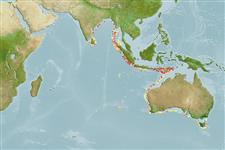Classification / Names
Nombres comunes | Sinónimos | Catalog of Fishes(Género, Especie) | ITIS | CoL | WoRMS | Cloffa
>
Aulopiformes (Grinners) >
Ipnopidae (Deep-sea tripod fishes) > Ipnopinae
Etymology: Bathypterois: Greek, bathys = deep + Greek, pterois = with wings (Ref. 45335); parini: Named in honor of Nikolay Vasil'evich Parin (Ref. 45719).
Environment: milieu / climate zone / depth range / distribution range
Ecología
marino batidemersal; rango de profundidad 560 - 875 m (Ref. 45719). Deep-water
Eastern Indian Ocean: Mentavay submarine ridge and western slope of Java, Indonesia.
Tamaño / Peso / Age
Maturity: Lm ? range ? - ? cm
Max length : 15.3 cm SL macho / no sexado; (Ref. 45719)
Short description
Morfología | Morfometría
Radios blandos dorsales (total): 13-15; Radios blandos anales: 9; Vértebra: 53 - 55. Cycloid, unarmed with spines and easily deciduous scales; well-developed adipose fin; 11-12 rays in lower portion of the pectoral fin; deep caudal peduncle (9.5-10.6% SL); large distance between pelvic and anal fins (24.4-26.1%) (Ref. 45719).
Life cycle and mating behavior
Madurez | Reproducción | Puesta | Huevos | Fecundidad | Larva
Shcherbachev, Y.N. and K.D. Sulak, 1988. A new species of the genus Bathypterois (Fam. Chlorophthalmidae) from the eastern part of the Indian Ocean. J. Ichthyol. 28(2):120-123. (Ref. 45719)
IUCN Red List Status (Ref. 130435)
Threat to humans
Harmless
Human uses
Más información
Nombres comunesSinónimosMetabolismoDespredadoresEcotoxicologíaReproducciónMadurezPuestaAgregación para la puestaFecundidadHuevosEgg development
Age/SizeCrecimientoLength-weightLength-lengthLength-frequenciesMorfometríaMorfologíaLarvaDinámica larvariaReclutamientoAbundanciaBRUVS
ReferenciasAcuiculturaPerfil de acuiculturaRazasGenéticaElectrophoresesheritabilidadEnfermedadesProcesamientoNutrientsMass conversion
ColaboradoresImágenesStamps, Coins Misc.SonidosCiguateraVelocidadTipo de nataciónSuperficie branquialOtolitosCerebrosVisión
Herramientas
Special reports
Download XML
Fuentes de Internet
Estimates based on models
Preferred temperature (Ref.
123201): 1.5 - 5.5, mean 2.3 °C (based on 9 cells).
Phylogenetic diversity index (Ref.
82804): PD
50 = 0.5000 [Uniqueness, from 0.5 = low to 2.0 = high].
Bayesian length-weight: a=0.01000 (0.00244 - 0.04107), b=3.04 (2.81 - 3.27), in cm total length, based on all LWR estimates for this body shape (Ref.
93245).
Nivel trófico (Ref.
69278): 3.4 ±0.4 se; based on size and trophs of closest relatives
Resiliencia (Ref.
120179): Bajo, población duplicada en un tiempo mínimo de 4.5-14 años (Preliminary K or Fecundity.).
Fishing Vulnerability (Ref.
59153): Low vulnerability (10 of 100).
